Search the Special Collections and Archives Portal
Search Results
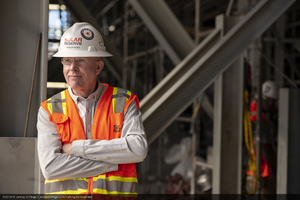
Portrait of Brian Painter, Project Director for construction of Crescent Dunes Solar, near Tonopah, Nevada: digital photograph
Date
Archival Collection
Description
Photographer's assigned keywords: "110 megawatts; Brian Painter; CSP; Concentrated Solar Energy; Concentrated Solar Power; Crescent Dunes; NV; Nevada; Solar Reserve; SolarReserve; Tonopah; concentrated solar thermal; green energy; ground-based photo; molten salt; on-site; renewable energy; storage; tower."
Image
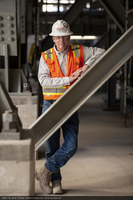
Portrait of Brian Painter, Project Director for construction of Crescent Dunes Solar, near Tonopah, Nevada: digital photograph
Date
Archival Collection
Description
Photographer's assigned keywords: "110 megawatts; Brian Painter; CSP; Concentrated Solar Energy; Concentrated Solar Power; Crescent Dunes; NV; Nevada; Solar Reserve; SolarReserve; Tonopah; concentrated solar thermal; green energy; ground-based photo; molten salt; on-site; renewable energy; storage; tower."
Image
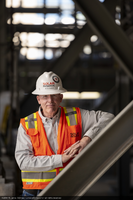
Portrait of Brian Painter, Project Director for construction of Crescent Dunes Solar, near Tonopah, Nevada: digital photograph
Date
Archival Collection
Description
Photographer's assigned keywords: "110 megawatts; Brian Painter; CSP; Concentrated Solar Energy; Concentrated Solar Power; Crescent Dunes; NV; Nevada; Solar Reserve; SolarReserve; Tonopah; concentrated solar thermal; green energy; ground-based photo; molten salt; on-site; renewable energy; storage; tower."
Image
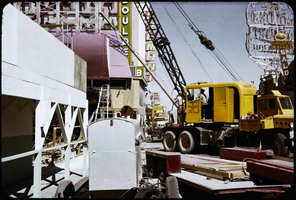
Photograph of The Mint Hotel and Casino sign construction, Las Vegas (Nev.), mid to late 1950s
Date
Archival Collection
Description
Image
Alfred Isola oral history interview
Identifier
Abstract
Oral history interview with Alfred Isola conducted by Stephen Kalish on March 15, 1976 for the Ralph Roske Oral History Project on Early Las Vegas. Isola discusses Las Vegas, Nevada’s lack of a unified garbage system and how dumping sites have had to adjust their practices in order to limit their impact on pollution. Isola also explains the different disposal protocols for wet and dry trash.
Archival Collection

Postcard of Desert Inn showroom, Las Vegas (Nev.), 1950-1980
Date
Archival Collection
Description
Image
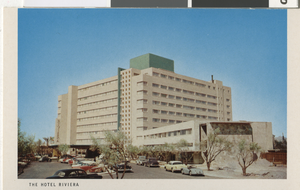
Photograph of the Hotel Riviera, Las Vegas (Nev.), 1940s
Date
Description
Image
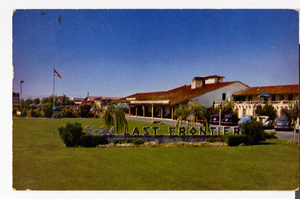
Postcard of Last Frontier 001
Date
Description
Image
Historic Building Survey Collection
Identifier
Abstract
The Historic Building Survey Collection (1930-2001) contains materials on the preservation of historic buildings in Southern Nevada, Arizona, and Utah from Dr. Ralph Roske's History 117 course taught at the University of Nevada, Las Vegas (UNLV). The collection is comprised of surveys which include descriptions, photographs, blueprints, newspaper clippings, pamplets, and fliers related to historic houses, businesses, and public sites.
Archival Collection
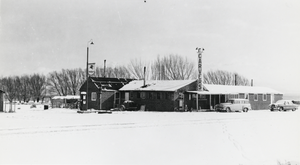
Bar in Carver's Station, Nevada: photographic print
Date
Archival Collection
Description
From the Nye County, Nevada Photograph Collection (PH-00221) -- Series V. Smoky Valley, Nevada and Round Mountain, Nevada -- Subseries V.A. Carver, Carver-Duhme, and Carver-Book Families (Smoky Valley). Originally the bar room in Carver’s Station was rather narrow; it was widened by bolting a number of 2-by-12s together and using that as a roof beam. Ground motion from the first atmospheric atomic test at the Nevada Test Site, located to the south, produced so much shaking that it broke the beam and caused the roof to sag. Ground motion from the nuclear tests at the Nevada Test Site is a common experience in Smoky Valley, and residents state that they sometimes feel motion from underground tests. Jean Carver Duhme still instinctively notes the time of any earth motion to determine if it is caused by an announced atomic test or by an earthquake. When tests were conducted in the atmosphere, Jean Carver Duhme does not recall seeing any visible clouds containing radioactive material moving up the Valley from the Test Site, but believes that the uranium "boom" during the 1950s at the Northumberland in the Toquima Mountains can be attributed more to fallout from nuclear testing than to naturally occurring uranium. During the atmospheric testing period, residents in Smoky Valley wore dosimeter badges, devices for measuring individual exposure to radiation. Dick Carver remembers his first experience of an atomic device being set off in the atmosphere at the Test Site. He arose very early one morning to go fishing in Jett Canyon in the Toiyabe Mountains. Prior to daylight he remembers seeing a "big flash of light.. brighter than daylight. And then it [got] dark again. It's amazing how bright it was," he recalls.
Image
